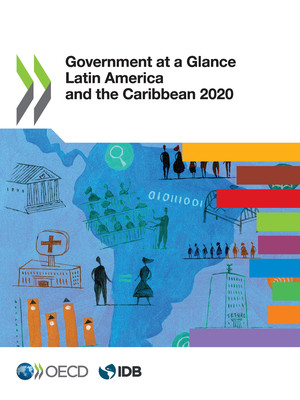copy the linklink copied!11.1. Trust in government
Trust is defined as a person’s belief that another person or institution will act consistently with their expectations of positive behaviour (OECD, 2017a). Trust is one of the most important foundations upon which the legitimacy and sustainability of a political system is built and is key for ensuring compliance with regulations and the tax system. Trust in government is essential for social cohesion and well-being as it affects government’s ability to implement reforms. Consequently, it is necessary for the fair and effective functioning of public institutions. There is consensus in the academic literature that trust influences the relationship between people and their government and has an impact on the outcomes of public policy (OECD, 2017b).
The most comprehensive source for internationally comparable trust data currently available is the Gallup World Poll covering LAC as well as OECD countries. On average trust levels in LAC reached 33.9% in 2018, 4.4 p.p. lower than in 2007, and below the OECD average of 45%. LAC countries where trust in government is the highest are Costa Rica (48%), Guatemala (46%) and Paraguay (46%). In the other end of the spectrum, trust is lowest in Argentina (26%), Venezuela (24%) and Brazil (17%). Between 2007 and 2018 trust increased the most in Paraguay (29 p.p.), Ecuador (28 p.p.) and Jamaica (17 p.p.) while the largest reductions occurred in Venezuela (39 p.p.), Uruguay (25 p.p.) and Colombia (24 p.p.).
Trust also varies along generational groups. Only 33.1% of those aged 15-29 reported trusting the government compared to 40.1% of those aged 50 or more, an average difference that is statistically significant. While there are statistically significant differences for some countries among these age cohorts, on average, differences are not statistically significant for OECD countries. In 2018, the largest differences in trust levels between the older and the younger cohorts in LAC were observed in Chile (23 p.p.), Venezuela (21 p.p.), Costa Rica (14 p.p.), and Colombia (14 p.p.). Young people in LAC countries tend to have higher education levels than their parents and more access to new technologies and information, all factors which contribute to shaping higher expectations and may increase demands from governments.
Measures of trust in government send signal about the current relationship of people with their institutions. They could also be read as an assessment of how governments are working and how public affairs are being conducted and could be also potential predictors of social upheaval. However, trust is influenced by a wide array of factors including approval of leadership. Furthermore, according to the academic literature, other factors such as, public sector integrity, the level of government openness, the quality of services and perceived fairness could also play a role in declared trust levels (OECD 2017b). Better understanding the drivers of trust requires disentangling its multidimensionality. Consequently, refined measurement of trust in government and public institutions as well as its drivers is needed to enable governments to propose and adjust actions for regaining trust from citizens.
Data are derived from the Gallup World Poll (GWP), which uses a statistically representative sample, generally of about 1 000 citizens in each country. However, in some countries samples may be smaller and/or refer exclusively to the capital or largest cities. The GWP includes questions on confidence in financial institutions, the judicial system, local police, the military and national government as well as a question on the approval of political leadership. The question on confidence in the national government does not differentiate between politicians and the bureaucracy nor does it specify which parts of national government are assessed. More information on the Gallup World Poll can be found at: www.gallup.com.
Further Reading
González, S. and C. Smith (2017), “The accuracy of measures of institutional trust in household surveys: Evidence from the OECD Trust Database”, OECD Statistics Working Papers, No. 2017/11, OECD Publishing, Paris, https://doi.org/10.1787/d839bd50-en.
OECD (2017a), OECD Guidelines on Measuring Trust, OECD Publishing, Paris, https://doi.org/10.1787/9789264278219-en.
OECD (2017b), Trust and Public Policy: How Better Governance Can Help Rebuild Public Trust, OECD Publishing, Paris, https://doi.org/10.1787/9789264268920-en.
Figure Notes
11.1 Data refer to the percentage of people who answered “yes” to the question “Do you have confidence in your national Government” Data for Jamaica, Peru, Trinidad and Tobago are 2017 rather than 2018. Data for Ecuador, Haiti, Jamaica, Panama and Trinidad and Tobago are 2006 rather than 2007.
11.2 95% confidence intervals are represented by H. Data for Jamaica and Trinidad and Tobago are 2017 rather than 2018
11.3 Data for the approval of country leadership represent the percentage of “approve” answers to the question: “Do you approve or disapprove the job performance of the leadership in this country? Data for Jamaica are 2017 rather than 2018
Metadata, Legal and Rights
https://doi.org/10.1787/13130fbb-en
© OECD 2020
The use of this work, whether digital or print, is governed by the Terms and Conditions to be found at http://www.oecd.org/termsandconditions.





